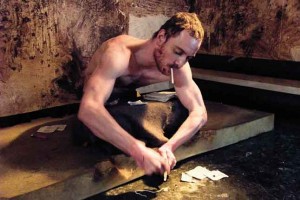« Features
Kettle’s Whistle / Gone to Hollywood

Michael Fassbender as Bobby Sands in HUNGER by Steve McQueen. Photo credit: © Blast! Films - Hunger Ltd. 2008 All Rights Reserved. (IFC Films)
By Michele Robecchi
The idea is not exactly new — in the past decades quite a few artists, including Larry Clark, Rebecca Horn, Isaac Julien, and Julian Schnabel, have given it a shot, with mixed results. Others, like Chantal Ackerman, Matthew Barney, Andy Warhol, and some Fluxus artists just paved their way through it by simply sticking to their usual self, and let the outside world come to terms with their craft. Finally, there’s a small group that made a serious attempt to cover the road coming from the opposite direction, like Peter Greenaway, Tim Burton, and Emil Kusturica, but none of the above ventured into the art world carrying their weapon of choice, opting instead for overly theatrical installations whose size matched their ego. What we are talking about here is the relationship between video art and mainstream film - two parallel universes that have often intertwined in the past and that, over the short spell of five years, have reached epidemic levels, as the work of Tracey Emin (Top Spot, 2006), Douglas Gordon and Philippe Parreno (Zidane: A 21st Century Portrait, 2006), Steve McQueen (Hunger, 2008), Pipilotti Rist (Pepperminta, 2009), Shirin Neshat (Women Without Men, 2009), and Sam Taylor-Wood (Nowhere Boy, 2009) all testify. (Anri Sala is apparently due to join the club sometime in 2011.)
Before falling into the trap of banal generalization, it’s worth noting where these productions come from. Steve McQueen, Shirin Neshat, and Pipilotti Rist have all been courted from popular media from quite a long time, and their enlistment in the army of artists-filmmakers was bound to happen eventually. Tracey Emin has tried out absolutely anything, from TV to novel writing, and her desire to tell the story of her life once more, this time wearing the director’s shoes, seems only logical. Douglas Gordon and Philippe Parreno fall in a category of artists that have always danced with the entertainment industry to a strange tune composed of open references and deconstructive moments, as in Gordon’s 24-Hour Psycho (1993) or Parreno’s appropriation, along with Pierre Huyghe, Dominique Gonzalez-Foerster, Pierre Joseph, and others, of the rejected Manga character Annlee in No Ghost Just a Shell (2002). As for Sam Taylor-Wood, she never made a secret of her love for pop culture. In 1993, together with British photographer Henry Bond, she reprised the roles of John Lennon and Yoko Ono to replicate the iconic shot of Annie Leibovitz, who famously made the cover of Rolling Stone in 1980 when Lennon was assassinated; in 2002, she made a portrait of David Beckham sound asleep for the National Portrait Gallery in London. Then there’s one of her most successful work, the parade of desperate Hollywood male stars in the photograph series Crying Men (2004). With such credentials, Taylor-Wood’s decision to officially start her film career with a biopic on the young John Lennon seems apt, if not completely full circle.
The limits imposed by Taylor-Wood’s choice are that, while as a visual artist you are free to expand your creative horizon in every conceivable direction, and as a director telling a real story you have to follow one significant guideline - stick to the facts. Such inhibitions could have concerned McQueen, too, if, like Lennon’s, the story of Northern Irish activist and hunger striker Bobby Sands would have been the subject of dozens of books, films, and whatnot, and patrolled 24/7 by an army of hardcore fans and acquaintances. But Sands’ story is only one chapter of a long chain of political events, and when his strike was on the news, McQueen was only 11 years old. He remembers the oddity of seeing the voice of someone taking a passive stance as refusing to eat getting louder, and this clever observation informs his film from beginning to end. While Sands’ ordeal is told with respect and sympathy, the viewer is put in a condition where it’s difficult to take sides, torn between the inmates passionately fighting for a just cause and the poor nurses and priests forced to deal with their stubbornness and radicalism on a daily basis. Exactly as it happens in his work, McQueen blurred the line between what’s personal and what’s collective, successfully exploring the flick format while staying loyal to his art. This latter aspect is crucial in the art film/film equation, but if it provides a satisfactory motivational explanation from the artist’s perspective, it doesn’t answer the big question - how a regular film audience, blissfully unaware of the author’s extracurricular activity, responds to this territory invasion? A casual look at box office results or comments on the Internet Movie Database (IMDB) suggest that the vast majority of the public focuses on the story and is not very prone to take the background of the director into account. Hence, McQueen’s film is extraordinary, Parreno and Gordon’s self-serving but good, Emin’s rubbish. It can be argued that this is Spice Girls logic, but that’s what you get when you enter the realm of entertainment.
Maybe the most interesting indication comes from Shirin Neshat. Deeply aware of the potential danger, she settled the question beforehand by putting together two separate versions of Women Without Men: one edited for gallery or museum spaces and one for theatres. A distinction that makes for a very problematic statement. Yet, patronizing as it might be, at least it’s honest, and it gives the audience the possibility to draw parallels between what an artist reckons is cinema, and what is art.


































